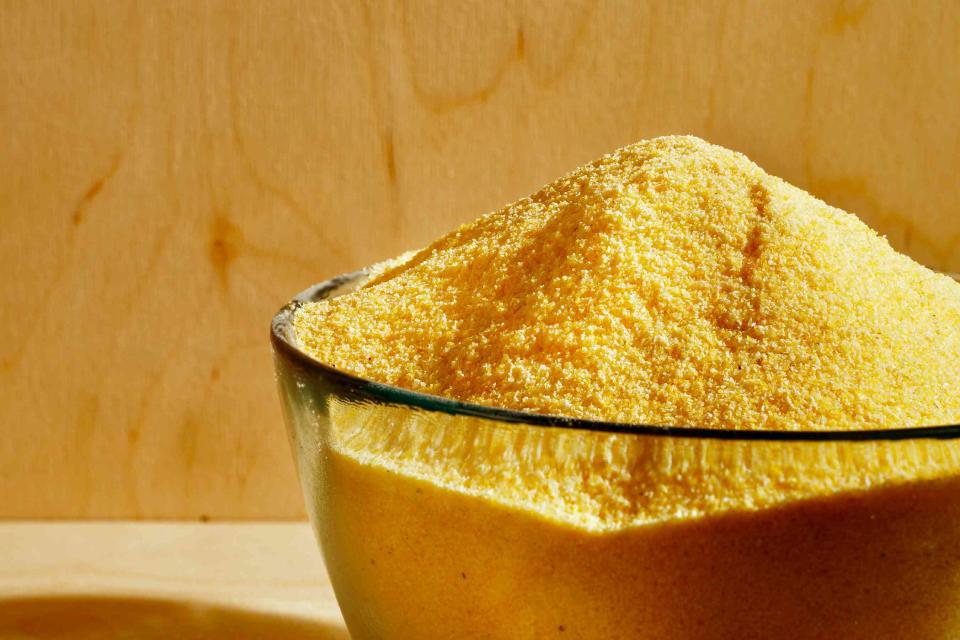Everything You Need to Know About Polenta
Learn how to buy, cook, and store this versatile grain.

Getty Images
Polenta is the name of both a coarsely milled yellow cornmeal, and the Italian dish traditionally made with it, which originated in Friuli-Venezia Giulia. “Polenta dates back to the beginning of cookery, pre-Roman and pre-Greek. In the Italian diaspora, polenta refers to a specific type of maize that was introduced through the Venice exchange,” says Glenn Roberts, founder of Anson Mills, who adds that he has some skepticism about the lore. For centuries, polenta was considered a food of shame, as the “corn mush” was served to slaves, he says, adding that it wasn’t until World War II that it became a respected part of Italian cuisine. Now, it's often served as a creamy bed for braised meats or seasonal vegetables, or as a side or brunch dish. Here’s what you should know about one of our favorite grains and Italian preparations.
The difference between polenta, cornmeal, and grits
On first glance, polenta, cornmeal, and grits seem similar; after all, they’re all derived from corn. But it’s the type of corn — and how it’s processed — that really distinguishes each product from one another.
“Traditionally, polenta is made from yellow corn and grits are made from white corn. Polenta is slightly coarser than grits,” explains Debbie La Bell, Director of eCommerce for Hayden Flour Mills. Grits are traditionally a product of dent corn, which refers to both white and yellow field corn that is soft and starchy. According to Roberts, grits are not made with uniformly ground corn; in fact, he argues that grits taste better when made with a variety of textures. Italian-style polenta, on the other hand, is made with flint corn, which has a harder texture than dent corn.
Cornmeal is any type of ground corn, ranging in texture from super course to finely ground corn that practically resembles flour. The hard endosperm particles are what gives cornmeal its texture, which is especially important for making cornbread. “The US Government recognizes polenta as just another stage of cornmeal, but try to tell an Italian that and you’ll probably have an argument,” Roberts says.
How to buy polenta
When looking for a bag of polenta in the grocery store, you’ll probably notice that there are a few options: instant, quick-cooking, or traditional polenta. Some brands may call their polenta “corn grits” or just “cornmeal;” the specific name of the product matters less than how it’s milled. The difference between them comes down to the grain itself. Instant or quick-cooking polenta will be finely ground, resembling regular cornmeal, so that it can absorb the cooking liquid in just a matter of minutes. Traditional-style polenta grains will be medium- or coarse-ground for the best texture.
How to cook polenta
Polenta is traditionally cooked slowly on the stovetop in water, milk, or stock and then mixed with butter, salt, pepper, and occasionally Parmesan or another cheese. When using coarse-ground polenta, the cooking process shouldn’t be rushed; a batch will usually take between 30 to 40 minutes to cook, compared to about 5 minutes for instant polenta. But there are options if you are short on time or don’t want to stand over the stove while cooking coarse polenata.
Try making an easy polenta that can sit, unattended, while the grains absorb the liquid. You can also bake polenta in the oven. Or, you can purchase fully cooked polenta, which is typically packaged and tightly wrapped in a roll. While you won’t be able to reheat and serve this as creamy, pourable polenta, you can slice and pan-fry it into crispy pucks or make it the topping of a gratin.
Polenta grains are also versatile in the kitchen for baking and savory cooking. Use polenta to make a pound cake or a Dutch baby, or add some to the topping of a cherry cobbler to give it more texture. Polenta can also be used to bread ingredients; try using it in oven-fried chicken, and take a tip from Yotam Ottolenghi and use polenta as the crust on crispy fish cakes.
How to store polenta
An unopened package of polenta typically has a shelf life of at least one year. “Once customers open the bag, we suggest storing the polenta in the fridge or freezer to maintain the freshness,” La Bell says. After opening a package of polenta, you should transfer the dry polenta to an airtight storage container and keep it in a dark, cool place. Cooked polenta may be stored in an airtight container and placed in the refrigerator for up to five days.
For more Food & Wine news, make sure to sign up for our newsletter!
Read the original article on Food & Wine.

